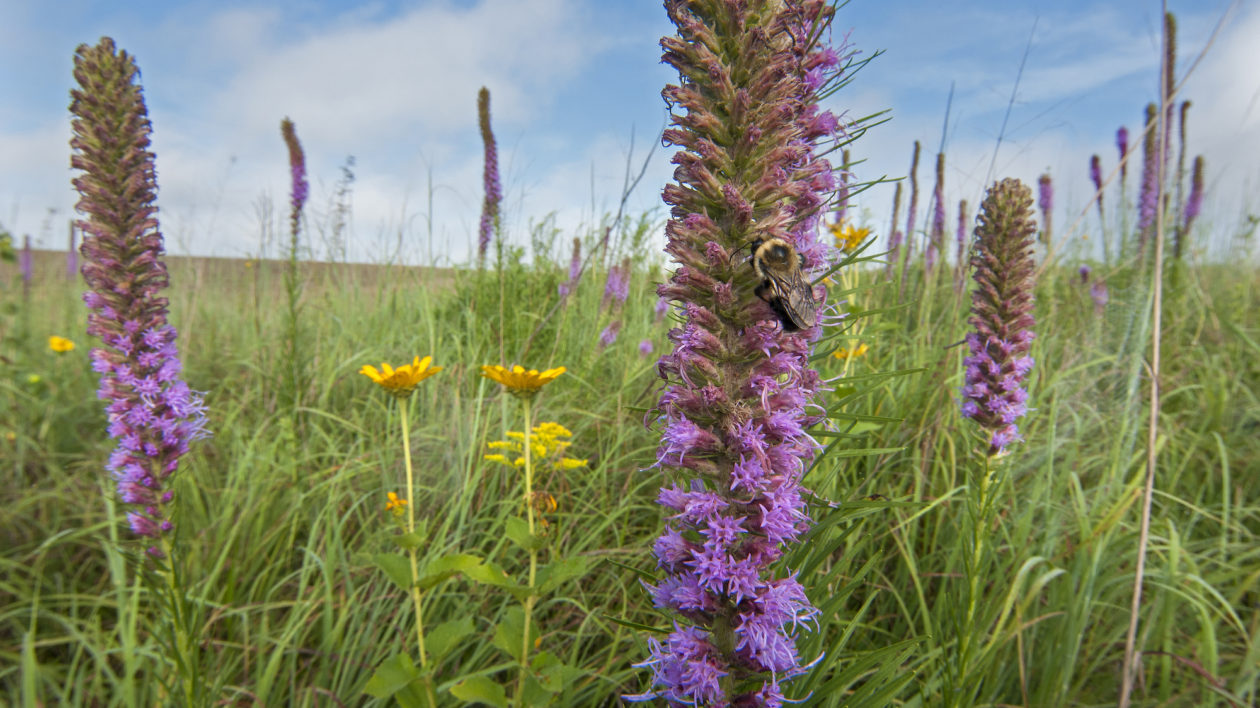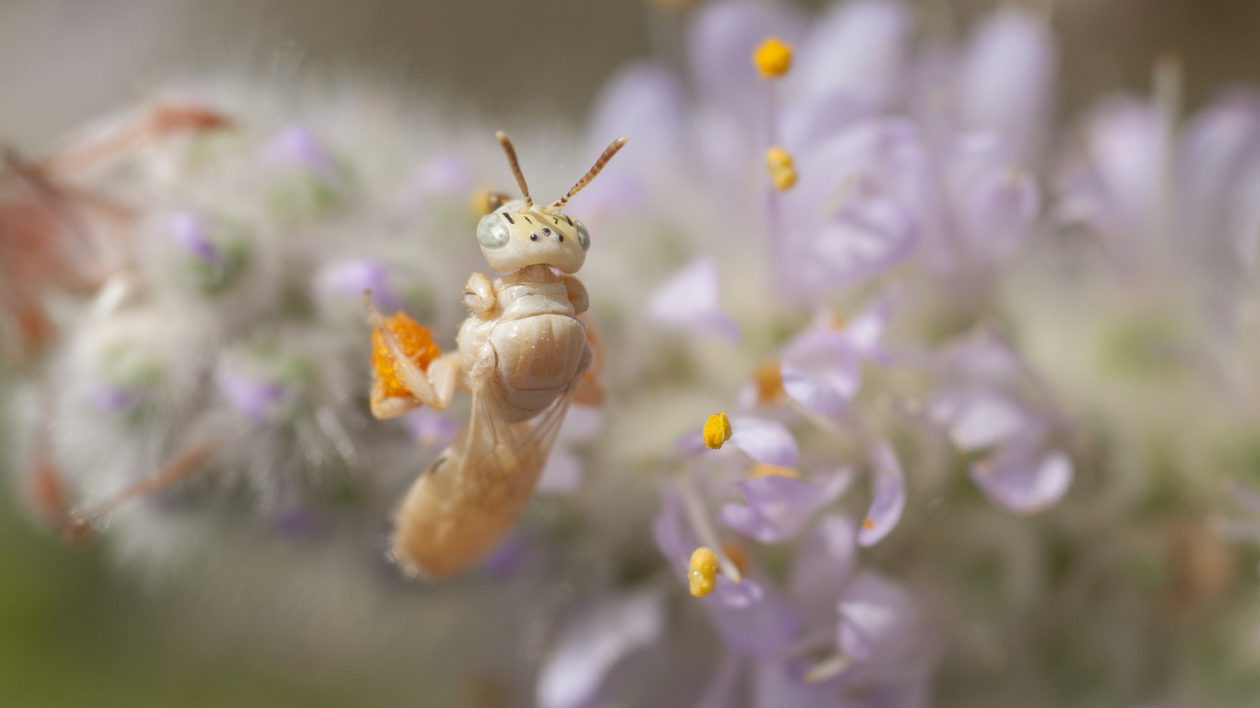The public is very aware that we are in the midst of a pollination crisis. In fact, concern about bees and other pollinators is nearly unanimous in public polling.
At a time when we are polarized on most issues, the need to do something about bees is something we can all agree on. Unfortunately, when people fret about bees and the threats they face, most are thinking about strictly about honey bees.
Honey bees are fascinating creatures. They’ve got an incredible social structure within their hives, they play important roles in the pollination of many food plants we like, and honey is delicious. However, honey bees are also an introduced livestock species in North America and only one of about 4,000 kinds of bees found in North America.
The thousands of native bee species living mostly below our collective radar are split into categories such as digger bees, carpenter bees, mason bees, sweat bees, bumble bees, and cuckoo bees.
The majority of those species don’t live in hives where workers cater to the needs of the queen and raise her babies for her. Instead, most native bees are reared in small nests built and tended by single mothers. Those female bees lay eggs, supply them with food, and protect them from enemies – all by themselves. A distinct minority of native bees live under some kind of cooperative system, and only a very few employ the kind of eusocial behavior we associate with honey bees.

The Dizzying Variety of Native Bees
Native bees also come in a dizzying array of colors, shapes, and feeding preferences. Bumble bees can be as large as your thumb, but many bee species are smaller than a grain of rice. Some are generalists that can feed opportunistically on whichever flowers are most abundant at the time.
Others are much more restricted in their diet, sometimes to a single species or group of species of wildflower. Plants, in turn, display a broad diversity of flower designs that can either make their nectar and pollen available to all comers or limited to only bees of a certain size, tongue length, or ability to vibrate flowers at a specific frequency.
Despite the astonishing variety among bees in North America, most conversations about bee conservation center on a single, largely agricultural species. Imagine if we did the same thing with birds — we’d be trying to raise more turkeys on farms out of concern for massive declines in overall bird populations.

To be clear, honey bees really are suffering declines. In fact, a recent report showed that around 38 percent of managed honey bee colonies in the U.S. were lost during the winter of 2018-19.
Honey bees are in no real danger of extinction, however, because humans are managing their populations. Native bees don’t have that kind of support system.
Honey bees also don’t cover the wide range of ecological roles played by our diverse native bee communities. The aforementioned variety of features and behaviors found within native bees means they can meet the needs of an incredible diversity of flowering plants. In contrast, honey bees provide pollination for a relatively small percentage of native flower species (estimates from around the world vary between 25 percent and 40 percent). In order to conserve the full species diversity and resilience of our ecosystems, we need our native bees.

The Fate of Native Bees
In addition to their inability to shoulder the entire load of pollination, there is also growing evidence that honey bees compete with and potentially contribute to the declines of native bees. That’s concerning, and it should make us thoughtful about how and where we place honey bee hives in and around natural areas. However, it’s also important to know that honey bees are not the primary reason our native bees are suffering.
In fact, honey bees and native bees share most of the same threats to their survival, with the loss of quality habitat topping that list. Similarly, many of the strategies to help save native bees will also help honey bees — and vice versa. We just need to be careful that saving honey bees aren’t the primary focus of conservation efforts or communications.
Increasing the size and quality of habitat for pollinators will boost populations of all bees, including both native bees and honey bees. Yes, certain pesticides and diseases are also causing major problems and we should continue to work on those issues as well.

However, adequate habitat quantity and quality greatly dampens the impacts of those other threats. We need to protect and restore plant diversity in natural areas and agricultural landscapes so that nectar and pollen resources are abundantly available throughout the year. In addition, we need to rebuild and reconnect floristically rich habitats wherever we can. Those are the only viable strategies to conserve bees of all kinds (and most of our native biodiversity).
Compared to those gargantuan tasks, changing the way we talk about bees seems pretty easy, but it is still really important. There are too many news stories that start with something like, “bees are suffering” and then proceed to talk only about honey bees.
Schools talk a lot about the social structure of honey bees, but don’t mention the majority of bees that don’t live that way. As a result, much of the public recognizes that we are experiencing a pollination catastrophe but thinks it’s an issue of bee keepers and their struggles to save their animals.
The real story of pollinators and their declines is much more compelling than the battle to save a livestock industry. The incredible variety among native bees, alone, can catch the public’s attention, especially when accompanied by photos showing the broad range of size, color, and shape among those bees.

People can also empathize easily with the extraordinary challenges facing single mom bees trying to feed and protect their progeny in a world of habitat fragmentation and degradation. Including butterflies, moths, flies, wasps and other insects in the discussion provides even more fascinating pollinator accounts and images.
The pollinator narrative is also easy to frame in ways that fit into the broader conservation context. Pollinators rely on habitat size, habitat connectivity, and plant diversity. Those are the key components of conservation success for most other species too, including our own.
Rebuilding and protecting the healthy and resilient landscapes bees need will provide for the needs of both nature and people. That’s a story we should be telling.

The public already cares about pollinators; we just need to be smarter about how we talk about them. If we’re successful, we’ll save much more than just bees. We can start by fixing our myopic focus on honey bees.
Turkeys are impressive and interesting creatures, but we’d never choose them as the primary focus of our bird conservation communications and strategies. Why, then, are we following that pattern for bees?
Let’s celebrate the incredible diversity of our native bee and pollinator communities and be more creative in the ways we engage the public on the topic of pollinator conservation. With 4,000 bee species in North America, along with countless other species of pollinators, it’s not like we’re short on material.




So I think the bird example should’ve been chickens as Turkeys are at least originally native to North America.
I know our pollinator’s have decreased in the last several years. I use to grow huge tomatoes, squash, okra, peppers, eggplants etc. I have almost thrown in the towel. But being a disabled vet. I just don’t know how to give up. I am a paraplegic but I don’t let that stop me. I figure next year on growing I am going to be planting a whole lot of different types of flowers. I know it has to be not planting my zinnia’s, and cosmos. I guess for every couple of plants there will be at least 2-4-1. flowers to veggies.
This is a wonderful synopsis of a fundamental issue. I became aware of native bees only after I started a backyard honeybee hive. As I fell in love with my bees I started photographing them; as I started photographing honeybees, I noticed all manner of other bees in the garden I had planted specifically for bird habitat. And I became a passionate native bee photographer and advocate. Thanks for this great article. https://dukkaqueen.com/a-thousand-bees-2/
The govt protects the spotted owl ,other etc. Why not the bees? It should become a political issue considering how important they are to our food survival.
Going beyond overly simplistic general reporting is any important task well done here. Besides bumblebees, what other native species are eusocial? Are common yellowjackets and paper wasps invasives too?
Thank you for this great article. I’ll make sure to share this information with others.
I loved this article! I grow herbs veggies and flowers organically in coastal Virginia. I am daily rewarded with visiting bees and all manor of pollinators. I keep a huge fennel plant by my house just so the swallow tail butterflies can leave their caterpillars for the next generation! Everyone can grow a plant to help out our insect friends! They bring joy and health!
Good lesson. Different varieties of bees and the difference between the Honey bees and Native bees. However what is still not clear to me is whether the native bees also produce honey. Another big lesson grasped is about the Pollinators relying on habitat size, habitat connectivity, and plant diversity, said to be key components of conservation success for most other species too, including our own.
Good article. Try focusing on Monsanto or Bayer for polination and suitable habitat for bees and see how far that goes. The diverse structure of plants and bees is upset by chemicals. My property is loaded with acres of wild flowers planted to help support my bees. I wish I had a suitable answer other then the obvious one that no one will follow due to the monitary issues that insue. I raise honey bees and sad to say it is a battle keeping them alive. I do not know of many bees that will produce honey like the inported bees. If you have that information I would be glad to see it. And yes there are other pollinators besides bees but they are by far the best.
Native bees need native plants. Read Doug Tallamy’s book Bringing Nature Home. Plant the things that they depend upon.
attend the symposium put on by the native plant society…it’s at Foothill College on September 21 , 2019It is about planting for biodiversity
.address of Foothill College is 12345 Moody Rd. Los Altos Hills, Ca.
I live in the rural Southeast and the predominate species of bees I attract is the bumble bee… They love the hyssop plants that flourish in a small part of my garden and have shown interest in the zinnia….How do I attract a greater variety of bees….We also have a few smaller bees that are very much like honey bees.
This is such an important message about our native bees!
Thank you so much for this article. I had no idea of such diversity. I’ll now definitely try to grow more native plants and flowers. Not too sure about eh habitat although I can guess a few holes in stone walls or a pile of wood debris should be a start. If you have any serious reference about it, I would be glad to delve into it!
I live about 40 min south of New Orleans. Urban setting but plenty of magnificent trees.
Gratefully
Dominique Le Bouteiller
My yard is full of Bees
Are the wasps and hornets attacking the beehives and killing the bee? This is something i heard.